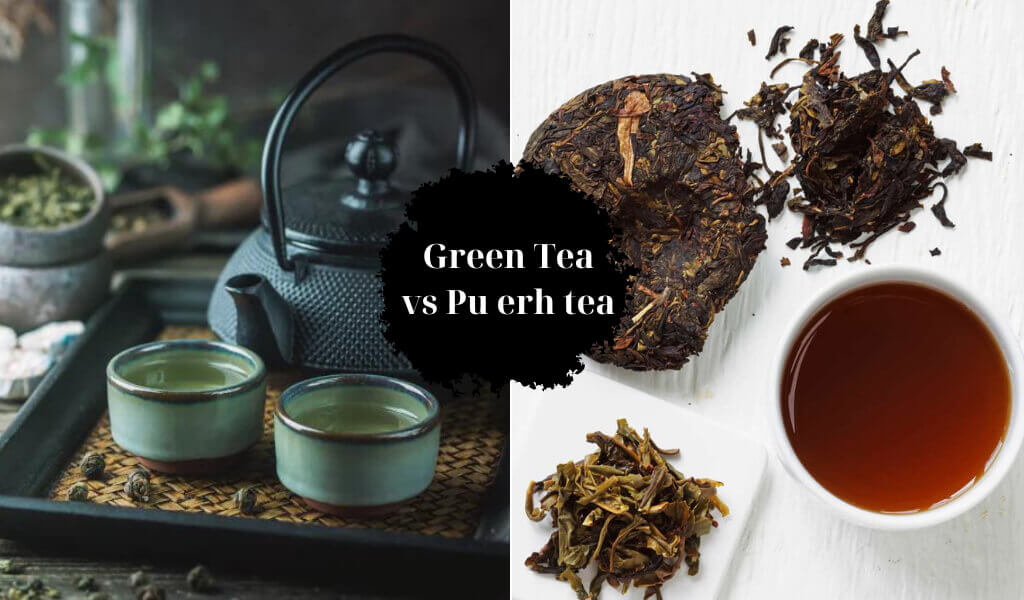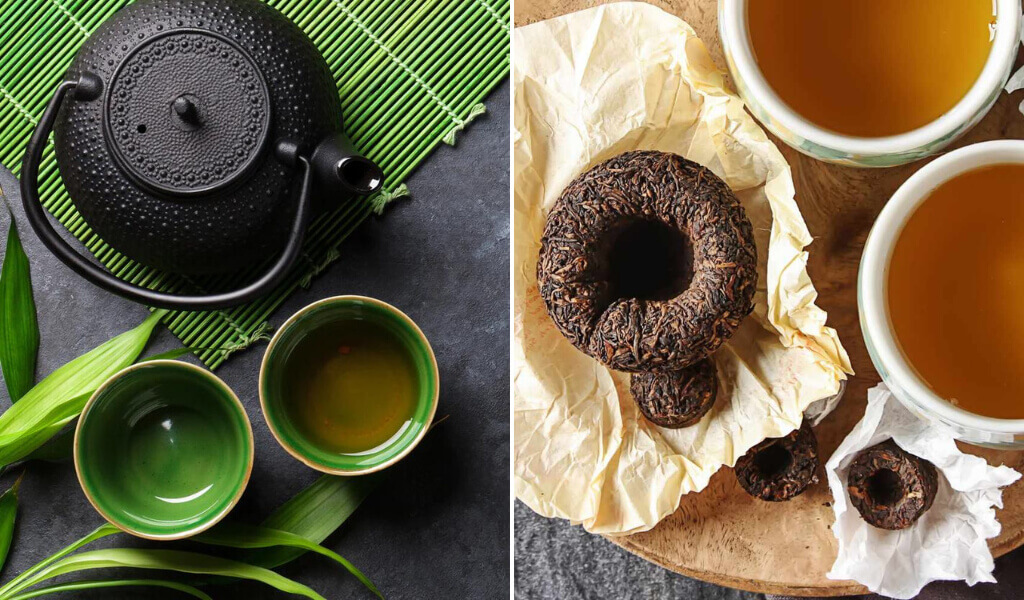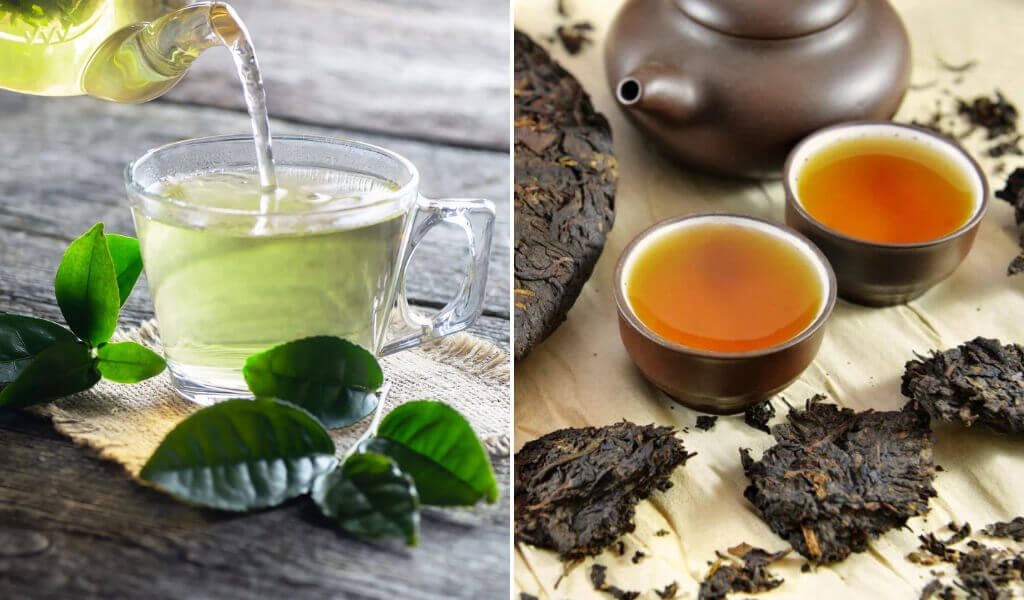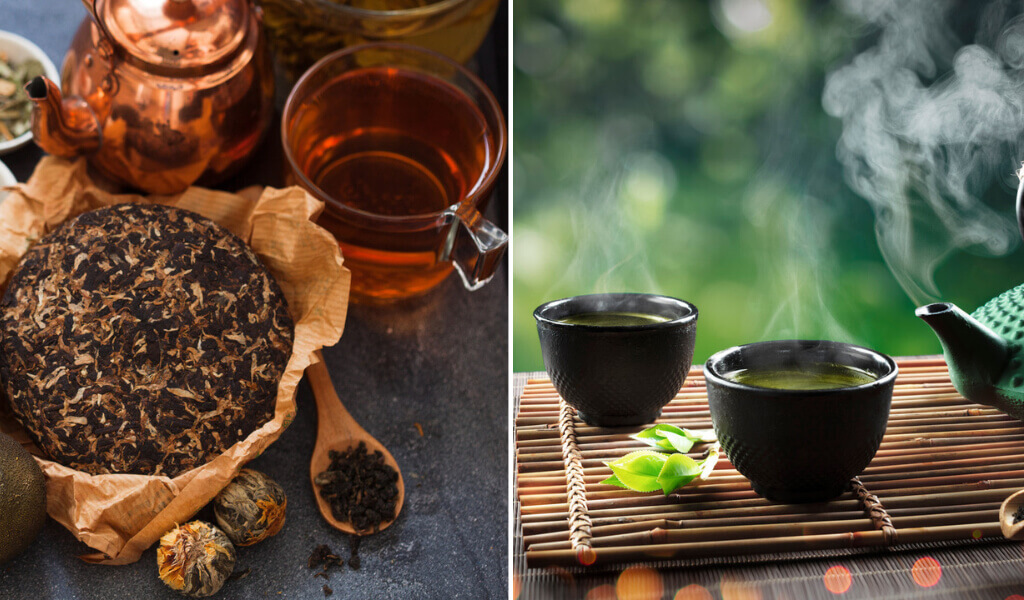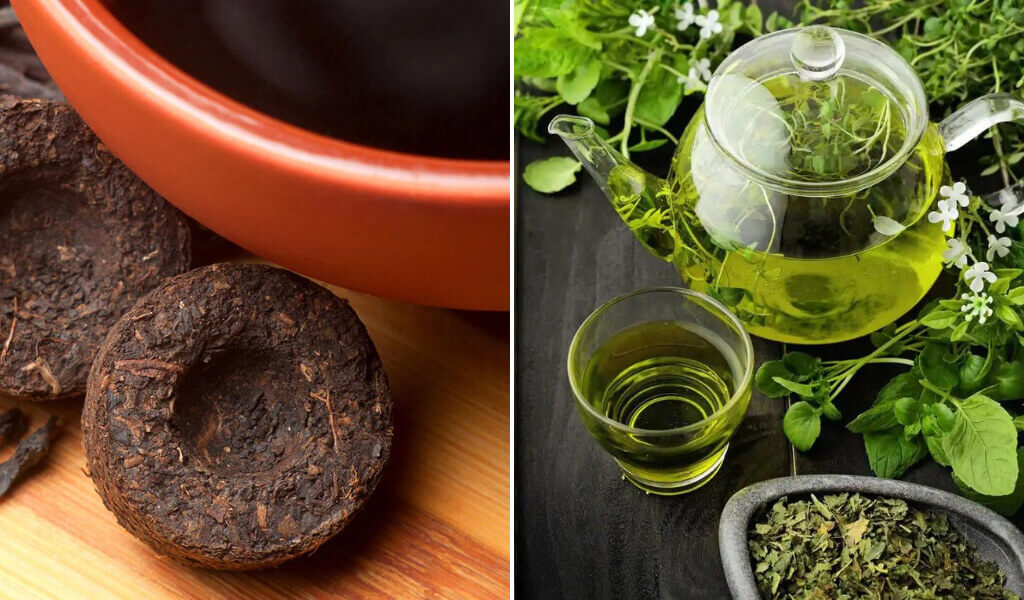Tea lovers often ask questions about Pu-erh tea. One of the most frequently asked questions is: “What is the difference between Green Tea vs pu erh tea?” The aroma and taste can be judged immediately, but for some friends who are new to Pu-erh tea, they are more challenging to distinguish.
Read More:
- Black Tea vs Green Tea: Some tips from tea Connoisseurs
- White Tea vs Green Tea: Ultimate comparison on distinctive features
- Benefits of Oong Tea vs Green Tea: What are the main difference?
Today, I will list some of the most intuitive identification methods to teach you to distinguish between raw and Green Tea quickly!
Quotes of tea with You
“When I drink tea I am conscious of peace. The cool breath of heaven rises in my sleeves, and blows my cares away.”
― Lo Tung
The basics of Green Tea vs pu erh tea
Green tea and Pu erh tea hold unique places in the wide and wonderful world of teas. Let me introduce you to these two captivating brews, each with its distinct character, history, and preparation method.
Green tea has always captivated me because of the captivating tale of its 3,000-year-old origin in ancient China. It is one of the healthiest drinks available in many different forms, including Sencha, Matcha, and Longjing, each with a unique flavor and look.
Making Green Tea is a fascinating process. The leaves are picked, quickly heated by pan firing or steaming to prevent oxidation, then rolled and dried. This careful preparation preserves the green color and delicate taste we’ve all come to appreciate.
The versatility of these teas is truly remarkable. They can accommodate a wide range of preferences, allowing you to find the ideal tea that perfectly suits your taste. Whether you’re an experienced tea enthusiast or just beginning your tea exploration, the delight comes from uncovering a brew that deeply connects with your personal preferences.
This gives Pu erh tea its unique, deep flavor and rich, earthy aroma that many tea enthusiasts, like myself, truly savor.
We’ll go deeper into these teas in the parts that follow, learning about their flavors, health advantages, and other aspects. So follow along as we explore the fascinating world of Green Tea and Pu Erh tea.
Here’s a quick comparison chart between Green Tea and Pu Erh tea:
| Criteria | Green Tea | Pu-erh Tea |
| Origin | Chinese | Chinese |
| Natural and Organic | Yes | Yes |
| Cultural Importance | Significant | Significant |
| Health Benefits | High antioxidant content, improved brain function, fat loss |
Aids digestion, reduces cholesterol, supports heart health, helps control diabetes
|
| Weight Loss Benefits | Boosts metabolism, increases fat burning | Reduces fat, prevents weight gain, aids digestion |
| Nutrition | Rich in vitamins (such as vitamin C), minerals (magnesium, zinc, potassium), and bioactive compounds (polyphenols, catechins) |
Contains magnesium, potassium, fluorine, and probiotics created during fermentation
|
| Production Process | Involves picking fresh leaves, killing greens, rolling, and drying |
Includes fresh leaf picking, drying, greening, rolling, drying, autoclaving, natural drying, and tissue paper packaging
|
| Taste | Fresh, sweet, mellow, elegant aroma | Rich, changing with age and growth environment |
| Shelf Life | 1-2 years with appropriate storage |
Depends on quality, techniques, and storage conditions. Can improve with age
|
| Growth Environment | Warm and humid climate at lower altitudes with distinct seasons and long light hours |
High-altitude, low-latitude environment with a subtropical warm and humid climate
|
| Price and Availability | Reasonably priced options for daily consumption, premium varieties can be expensive |
Younger teas are affordable, aged teas can be very expensive
|
| Role in Tea Ceremonies | Plays a significant role | Plays a significant role |
| Product Name Definition | Derived from the tea tree’s fresh buds or leaves |
Derived from Yunnan’s big-leaf sun-dried green tea
|
| Material Selection | Focuses on tenderness, higher grades are considered better |
Influenced by factors like the natural environment, tree age, and picking season
|
What are the Similarities Between Green Tea vs Pu Erh tea?
While Green Tea and Pu Erh tea have distinct characters, striking similarities make them siblings in the vast tea family. Let’s look at some of these shared attributes.
- Origin: I’d like to point out that the first similarity is their Chinese origin. These teas have deep roots in Chinese history and culture, making them a crucial part of the country’s rich heritage.
- Natural and Organic: Green tea and Pu Erh tea are derived from the Camellia sinensis plant. This gives them an organic, natural basis, unlike other beverages containing artificial ingredients or additives.
- Cultural Importance: Besides their health properties, both teas are significant in Chinese cultural traditions and ceremonies, such as the famous Gongfu Tea Ceremony.
What’s the difference between Pu Erh and green tea?
Pu-erh Tea vs Green Tea Benefits
Pu-Erh tea is known for its potential to aid digestion and reduce cholesterol. Some studies suggest it may also support heart health and help control diabetes.
Conversely, Green tea is widely recognized for its high antioxidant content, which can help reduce inflammation and may even aid in cancer prevention. It’s also associated with improved brain function and fat loss, making it a wellness powerhouse.
Green tea vs Pu Erh tea weight loss
Now, if you’re curious about Green Tea vs pu-erh tea for weight loss, both may aid your journey. Green tea contains catechins and caffeine, which boost metabolism and increases fat burning.
A cup of green tea can be a refreshing day start while supporting my fitness goals.
Pu-erh tea’s weight loss benefits are attributed to the presence of theanine and polyphenols. These compounds are thought to help reduce fat and prevent weight gain. Drinking a cup of Pu-erh tea after a heavy meal can aid in digestion and assist in managing weight.
Green tea vs pu erh tea nutrition
In terms of nutrition, both Green Tea and raw Pu Erh tea have their unique offerings.
Vitamin C and minerals including magnesium, zinc, and potassium are abundant in Green Tea. Additionally, its high concentration of bioactive substances like polyphenols and catechins adds to its host of health advantages.
In addition to various other nutrients, Pu Erh tea contains fluorine, magnesium, and potassium. It’s worth mentioning that the fermentation process of raw Pu Erh tea leads to the development of beneficial probiotics, which can greatly benefit gut health, adding yet another dimension to the nutritional benefits of pu-erh tea.
Tea Product Names Defined
When it comes to defining these teas, it gets interesting. Raw Pu-erh tea, derived from the protected area of the Dili mark, is produced from Yunnan’s big-leaf sun-dried Green Tea. The unique process gives it a flavor that is undeniably it’s own.
On the other hand, Green Tea is a product of the tea tree’s fresh buds or leaves. They’re picked and processed through various methods, such as killing green, kneading, and drying. This results in Green Tea varieties that can be fried, baked, or steamed.
Something to note: raw Pu-Erh tea is region-specific. It has to be produced in Yunnan. Green tea is more versatile and can be produced in various parts of the country.
Green tea vs Pu Erh tea health benefits and material selection
Raw Pu-erh tea offers a wide variety due to factors like the natural environment, tree age, and picking season of the tea-producing areas.
I love how these factors influence the taste of raw Pu Erh tea. Its core production areas are Xishuangbanna, Lincang, and Pu’er, each offering different mountain ranges and villages. Teas are grown in different environments within the same mountain yielding different styles of tea products.
For instance, Laoman’e in Bulang Mountain, Bulang Township, Menghai County, Xishuangbanna, produces raw Pu’er tea with a strong taste and bitter flavor. This is due to factors like climate, soil, and human interference.
Nevertheless, the initial bitterness swiftly transforms into a delightful sweetness, rendering this tea truly distinctive. The Hekai ancient tea mountain in Xishuangbanna provides an ideal environment for tea trees, yielding raw Pu’er tea that possesses an enchanting wild essence and a lingering aroma.
When it comes to selecting Green Tea, the emphasis primarily lies in its tenderness. The superior grades are deemed superior in quality. Consider West Lake Longjing tea and Anji white tea as examples. They exclusively use a single bud and leaf as their raw ingredients, resulting in tea that is fresh, sweet, and imbued with a fragrant essence.
Manufacturing Process
Green tea, the most common tea type, involves picking fresh leaves, killing greens, rolling, and drying.
The greening process comes in different methods: sun-dried greens, steamed greens, baked greens, and fried greens. Green tea is dried at high temperatures, reducing the activity of enzymes in the leaves and preventing further transformation into other tea products.
The production process of raw Pu-erh tea includes fresh leaf picking, drying, greening, rolling, autoclaving, natural drying, and tissue paper packaging. The temperature of the fresh leaves does not exceed 80°C.
After kneading and shaping, the leaves are sun-dried at a lower temperature. This low-temperature process ensures that the enzymes remain active and, under suitable storage conditions, can enrich and transform the tea leaves.
Green tea vs pu erh tea taste
Green tea is known for its freshness, sweetness, and mellowness. It carries an elegant aroma and is considered top-grade if it doesn’t have a miscellaneous taste.
Raw Pu-erh tea, on the other hand, offers a rich taste that changes with age. The taste also varies depending on the tea tree’s growth environment. For example, the 2016 “Wufeng” Yiwu ancient tree spring tea has a delicate, full soup with a strong aroma. Its taste lingers, making it a delightful experience.
Shelf Life
Being fresh and easily affected by high temperatures, Green Tea can’t continue to ferment and transform in storage. Therefore, its shelf life is short, usually 1 to 2 years, under appropriate storage methods.
The shelf life of raw Pu-erh tea depends on quality raw materials, exquisite tea-making techniques, and suitable storage conditions.
Many active substances, such as enzymes, can be retained in the tea, ensuring that the tea product can undergo self-transformation during storage. It’s best to store it in odor-free, ventilated, and light-free conditions for optimal transformation.
Differences in Growth Environment
Understanding the growth environments of Pu-erh and Green Tea gives us more insight into their unique traits.
Pu-erh tea trees flourish in a geographical setting characterized by high elevations and proximity to the equator. The ideal conditions include a subtropical climate with warm temperatures, high humidity, ample rainfall, and abundant sunlight. These weather patterns create a perpetual veil of mist and cloud cover throughout the year, providing an ambiance akin to everlasting springtime. Additionally, the soil in this region possesses a mild acidity, with a pH level ranging from 4.5 to 6.5.
Green tea prefers a different setting. It grows in a warm and humid climate but at lower altitudes. Here, the four seasons are distinct, with fewer clouds and fog and long hours with high light intensity.
This environment is less conducive to the metabolism of nitrogen compounds in the tea buds and leaves and the absorption and synthesis of light quanta. As a result, Green Tea’s chlorophyll, carotene, protein, and amino acid content are noticeably less than in Pu’er tea.
Pu-Erh Tea Caffeine Vs Green Tea
One key aspect to consider when comparing Pu-erh tea and Green Tea is their caffeine content. Pu-erh tea generally contains higher levels of caffeine compared to Green Tea.
Pu-erh tea is a fermented tea that undergoes a longer fermentation process, which can result in higher caffeine levels. On the other hand, Green Tea is unfermented and typically contains lower levels of caffeine.
The caffeine content in tea can vary depending on factors such as the specific tea leaves, brewing time, and water temperature. However, as a general guideline, Pu-erh tea is known to have a higher caffeine content compared to Green Tea.
Price and Availability
For Green Tea, you can find reasonably priced options for daily consumption, but if you’re looking for premium stuff like Gyokuro or Matcha from Japan, or Dragonwell from China, it can get more expensive. I’ve seen high-quality green teas reach up to $30 or even $50 for just a few ounces.
Pu-erh Tea, on the other hand, is unique. Younger, raw Pu-erh Teas are generally affordable, but aged Pu-erh Teas can command high prices due to their rarity and the time involved in aging. It’s common for aged Pu-erh teas to cost hundreds or thousands of dollars!
Share the article to support Spiriteadrinks. Thanks
FAQs
How do the fermentation processes of Green Tea and Pu-erh Tea differ?
Green Tea is not fermented; it’s processed to prevent oxidation, keeping the leaves green. In contrast, Pu-erh Tea undergoes a unique fermentation process, contributing to its distinct flavor and health benefits.
Are there any specific brewing techniques for Green Tea and Pu-erh Tea?
The recommended water temperature for Green Tea is approximately 80°C (176°F), while Pu-erh Tea can be brewed with boiling water at 100°C (212°F). Adjusting the brewing time can enhance the flavors of both teas.
Which type of tea is more popular worldwide, Green Tea or Pu-erh Tea?
Green Tea is widely consumed worldwide due to its light, refreshing taste and health benefits. However, Pu-erh Tea has gained popularity among enthusiasts for its unique flavor and health properties.
I’m Shanna, creator of Spiritea Drinks. I’m all about teaching people to grow their own food, tea, cook what they harvest, and eat with the seasons.

